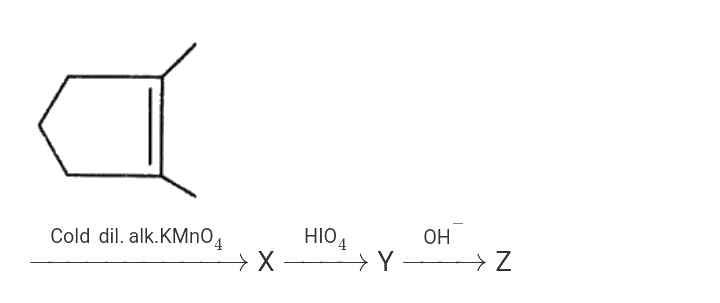CH≡CHHgSO4−−−→H2SO4(X)LiAIH4−−−−→(Y)P4/Br2−−−−→(Z)
In this sequence of reaction, the (Z) is:
Ethylene bromide
Ethanol
Ethyl bromide
Ethylidene bromide
The correct Answer is:C
To solve the given reaction sequence step by step, let's analyze each reaction carefully:
Step 1: Reaction of Alkyne with H₂SO₄
The starting compound is an alkyne, represented as CH≡CH (ethyne or acetylene). When this alkyne reacts with sulfuric acid (H₂SO₄) in the presence of mercury(II) sulfate (HgSO₄), it undergoes hydration.
The reaction proceeds as follows:
- The alkyne reacts with H₂SO₄ to form an intermediate vinyl alcohol (enol), which is CH₂=CHOH (vinyl alcohol).
- This vinyl alcohol then undergoes tautomerization to form an aldehyde. In this case, the aldehyde formed is acetaldehyde (ethanal), represented as CH₃CHO.
Thus, the product of this step (X) is:
X=CH₃CHO
Step 2: Reduction with Lithium Aluminum Hydride (LiAlH₄)
The next step involves the reduction of the aldehyde (X) using lithium aluminum hydride (LiAlH₄).
The reaction is as follows:
- LiAlH₄ is a strong reducing agent that reduces aldehydes to primary alcohols.
- Therefore, the acetaldehyde (CH₃CHO) will be reduced to ethanol (CH₃CH₂OH).
Thus, the product of this step (Y) is:
Y=CH₃CH₂OH
Step 3: Reaction with Phosphorus and Bromine (P₄/Br₂)
In the final step, ethanol (Y) is reacted with phosphorus (P₄) and bromine (Br₂). This reaction is known as the Hell-Volhard-Zelinsky (HVZ) reaction.
The reaction proceeds as follows:
- Phosphorus reacts with bromine to form phosphorus tribromide (PBr₃).
- The hydroxyl group (-OH) of ethanol reacts with PBr₃, leading to the formation of an intermediate that ultimately results in the substitution of the hydroxyl group with a bromine atom.
As a result, we obtain bromoethane (ethyl bromide), represented as CH₃CH₂Br.
Thus, the final product (Z) is:
Z=CH₃CH₂Br
Final Answer
The compound Z is bromoethane (ethyl bromide).
The starting compound is an alkyne, represented as CH≡CH (ethyne or acetylene). When this alkyne reacts with sulfuric acid (H₂SO₄) in the presence of mercury(II) sulfate (HgSO₄), it undergoes hydration.
- The alkyne reacts with H₂SO₄ to form an intermediate vinyl alcohol (enol), which is CH₂=CHOH (vinyl alcohol).
- This vinyl alcohol then undergoes tautomerization to form an aldehyde. In this case, the aldehyde formed is acetaldehyde (ethanal), represented as CH₃CHO.
X=CH₃CHO
The next step involves the reduction of the aldehyde (X) using lithium aluminum hydride (LiAlH₄).
- LiAlH₄ is a strong reducing agent that reduces aldehydes to primary alcohols.
- Therefore, the acetaldehyde (CH₃CHO) will be reduced to ethanol (CH₃CH₂OH).
Y=CH₃CH₂OH
In the final step, ethanol (Y) is reacted with phosphorus (P₄) and bromine (Br₂). This reaction is known as the Hell-Volhard-Zelinsky (HVZ) reaction.
- Phosphorus reacts with bromine to form phosphorus tribromide (PBr₃).
- The hydroxyl group (-OH) of ethanol reacts with PBr₃, leading to the formation of an intermediate that ultimately results in the substitution of the hydroxyl group with a bromine atom.
Z=CH₃CH₂Br
The compound Z is bromoethane (ethyl bromide).
Topper's Solved these Questions
- ALIPHATIC AND AROMATIC ALDEHYDES AND KETONESBOOK - CENGAGE CHEMISTRY ENGLISHCHAPTER - ALIPHATIC AND AROMATIC ALDEHYDES AND KETONESEXERCISE - Exercises Assertion-Reasoning
6 Videos
- ALIPHATIC AND AROMATIC ALDEHYDES AND KETONESBOOK - CENGAGE CHEMISTRY ENGLISHCHAPTER - ALIPHATIC AND AROMATIC ALDEHYDES AND KETONESEXERCISE - Archives Objective
10 Videos
- ALIPHATIC AND AROMATIC ALDEHYDES AND KETONESBOOK - CENGAGE CHEMISTRY ENGLISHCHAPTER - ALIPHATIC AND AROMATIC ALDEHYDES AND KETONESEXERCISE - Exercises Multiple Correct
33 Videos
- ALCOHOL,PHENOL AND ETHERSBOOK - CENGAGE CHEMISTRY ENGLISHCHAPTER - ALCOHOL,PHENOL AND ETHERSEXERCISE - Archives Analytical And Descriptive
15 Videos
- APPENDIX INORGANIC VOLUME 2BOOK - CENGAGE CHEMISTRY ENGLISHCHAPTER - APPENDIX INORGANIC VOLUME 2EXERCISE - Short Answer Type
179 Videos
Similar Questions
Knowledge Check
Identify (X), (Y) andc (Z) in the given reaction :
CH3CHOK2Cr2O7−−−−−→H2SO4(X)PCl5−−→(Y)C6H6−−−−−→anh.AlCl3(Z)A(X)=HCOOH,(Y)=COCl2,(Y)=COCl2,(Z)=C6H5ClB(X)=CH3COOH,(Y)=CH3COCl,(Z)=C6H5COCH3C(X)=CH3COOH,(Y)=CH3CH2CH2Cl,(Z)=C6H5CH2CH2CH3D(X)=CH3COCH3,(Y)=CH3CHClCH3,(Z)=C6H5COCH3
H−C≡C−HHgSO4−−−−−−→H2SO4dil.NaOH−−−−−→Δ−−→P. The final product P is
View SolutionC2H2Hg(OH)21%−−−−−−−−−−→H2SO4A[O]−−→B, B is :
View SolutionPh−CH=CH−PhCl2−−→CCl4X2NaNH2−−−−→YH2,Pd−CaCO3−−−−−−−−−→Z
Identify product (Z) of the reaction.
View SolutionC2H4Br2−−→XKCN−−→Y,Y is
View SolutionIsopropylamine KMnO4−−−−→XH+3O−−→Y
In the above sequence X and Y are
View SolutionIn the reaction sequence
C6H5CHONH2OH/H⊕−−−−−−−−→Δ(X)P2O5/Δ−−−−−→(Y)H2O,H+−−−−−→(Z)
(X), (Y) and (Z) respectively be
View SolutionHNO3/H2SO4−−−−−−−−→ANaOH−−−−−→433KB, B is

View Solution

_S01_475_Q01.png)
